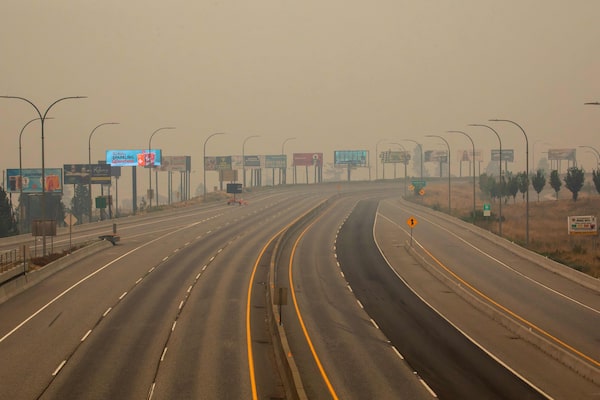
Empty highways are seen in West Kelowna, B.C., on Aug. 20, as people are asked by authorities to stay off the roads because of wildfires.DARREN HULL/AFP/Getty Images
An immense blanket of smoke helped cool B.C.’s threatened Okanagan region enough this weekend for crews in and around Kelowna to confirm more than 55 homes and other buildings were damaged by a massive wildfire.
But firefighters also found five neighbourhoods in West Kelowna that were threatened had escaped intact, local emergency officials said at a Monday briefing.
Fire chiefs from Kelowna, West Kelowna and two other smaller communities said the fumes have made it impossible for an aerial assessment of the damage wrought by the 110-square-kilometre McDougall Creek fire, which jumped from near West Kelowna over Okanagan Lake on Thursday evening to threaten neighbourhoods north of downtown Kelowna.
People remained evacuated from 9,855 properties in the two communities, which have a combined population of roughly 190,000 that swells with tourists each summer. Across British Columbia, fires had forced local authorities to put more than 27,000 people under evacuation order and more than 35,000 on evacuation alert as of Monday morning.
After crews were able to make progress fighting the Kelowna-area fires on Sunday, local fire chiefs told the press conference that crews will be taking advantage of good weather to go into neighbourhoods and extinguish fires around homes and create a guard against the blaze, which could be hit by higher winds from Tropical Storm Hilary this week.
The BC Wildfire Service says this new weather could challenge firefighters already battling hundreds of fires across the province that have caused a provincial state of emergency. The agency said there have been no confirmed lives lost over the weekend and the province has also not received any missing-persons reports related to these fires.
But West Kelowna Fire Chief Jason Brolund underscored the active threat posed by the McDougall Creek fire: Firefighters coming back from the night shift Monday morning had their faces totally blackened by soot.
“They were out there doing that grind, that hard work of firefighting all through the night,” he said at the press conference.
Mr. Brolund said initial assessments have begun and found at least 50 local structures have been lost, with whole neighbourhoods spared. He cautioned that the destruction of more houses is likely to be confirmed in the coming days as authorities comb through the other neighbourhoods hit hardest by the natural disaster.
The fire chiefs said they expect they will be able to start reaching out to evacuees over the next few days to inform them whether their homes survived the fire. Five homes have been confirmed destroyed by the wildfire in Kelowna, while the District of Lake Country to the north has lost up to three homes.
Since fleeing on Thursday, many locals had turned to social media to share snapshots from their porch cameras to determine the state of their house and their neighbourhood.
The Decibel: The people most affected by wildfire smoke
Prime Minister Justin Trudeau hailed the emergency responders and other Canadians rallying to fight the wildfires causing “apocalyptic devastation” as they rip through neighbourhoods and force people to flee.
Mr. Trudeau was in Prince Edward Island on Monday ahead of a three-day cabinet retreat where he and his ministers will set a policy agenda for the government. Before that gathering began, he called another emergency meeting of cabinet’s incident response group to make sure the federal government is doing “everything necessary to keep people safe and co-ordinate with the provinces.”
After the meeting the Prime Minister’s Office issued a statement highlighting various government programs that evacuees can turn to for income support, including employment insurance, and noted that Service Canada hours have been extended.
Wildfire maps 2023: Tracking fires and air quality across Canada
The federal government’s wildfire tracking shows most of B.C. and much of Alberta and the Northwest Territories are at high to extreme risk of more wildfires, with Northern Saskatchewan, Ontario and Quebec also experiencing out-of-control blazes.
Favourable weather for firefighting is expected in B.C. this week, but the situation remains serious across the province.
Premier David Eby asked people to respect the travel order his government imposed on Saturday banning tourists from the Thompson-Okanagan region – one of the province’s top summer destinations.
“Please understand this is a very stressful situation for people in these local areas. The last thing they need is disaster tourists coming and interfering with rescue efforts,” he said at a press conference on Monday afternoon.
The order, effective until Sept. 4, restricts travel for anyone planning on renting a room in Kelowna, Kamloops, Oliver, Osoyoos, Penticton and Vernon.
WestJet issued a statement Monday saying it would decide in the evening whether to go ahead with flights to and from Kelowna and urged its passengers to check their flight status before heading to that airport.
Emergency Management Minister Bowinn Ma said on Monday that conditions have improved in the Kootenays region and communities there are looking forward to welcoming tourists.
“We are no longer asking people to stay out of the southeast in its entirety. But there is still a need to recreate responsibly,” she said.
With reports from Marieke Walsh and The Canadian Press
Emergency resources for B.C. residents
- B.C. residents who require emergency support services can register here. Emergency evacuee guidance can be found here.
- The latest news, including notices, alerts, and orders, can be found here.
- Residents can request up-to-date information here. Report smoke or fire by calling 1-800-663-5555
- Visit your local authority or First Nations' website for regional information.